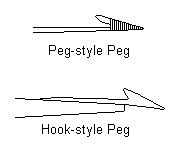|
Daryl Hrdlicka Jeffers Petroglyphs Historic Site February 15, 2003 While atlatl pegs come in a number of different styles, I'm not aware of any formal means of classification. I feel there's a need for a classification system, if for no other reason than a common frame of reference for comparing atlatl styles. The peg, or point of contact between the atlatl and the dart end, comes in two "genders": male, with a peg that fits into a hole in the dart end, and female, with a socket for the dart itself to fit into. While Papua New Guinea spearthrowers and some Arctic throwing-boards are female, the vast majority of atlatls around the world are male.  Male pegs also come in two styles, carved and separate Carved pegs are part of the atlatl itself, simply carved onto the end of the shaft. Separate pegs, on the other hand, are just that -- a separate piece which is attached to the atlatl in some fashion.  Separate pegs can made from a variety of materials. Ones have been found made of wood, bone, antler, stone, horn, tooth, claw, and resin. There are a number of ways they can be attached to the atlatl shaft.
These give us enough information to build a classification system. An atlatl peg may be:
Every atlatl I'm aware of falls into one of these categories. You could also subdivide them further according to the peg material, but I don't think that's a valid distinction. There's no real difference in performance between a wood, antler, or tooth peg, and it may be a cosmetic choice rather than a real difference in style and usage. To be honest, this classification system isn't something there was a great need for, but it is useful. For one thing, it can be used to easily describe or categorize atlatls. But it also helps plot atlatl variations around the world. Why are Papua New Guinea and Arctic styles female, and does this style occur anywhere else in the world? Was there a link of some kind between these cultures? While this is only one factor, it may lead to some interesting conclusions. |


